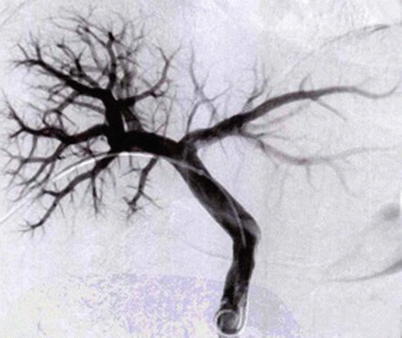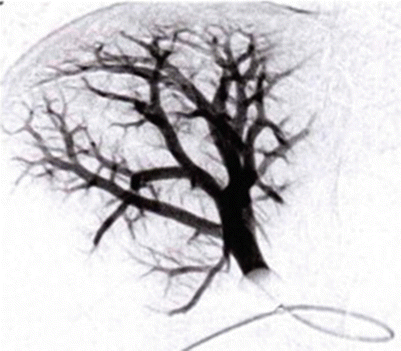Fig. 25.1
Portal vein puncture
25.2 History
In 1920, Rous first observed ligated lobe atrophy and un-ligated lobe regeneration after ligation of one branch of the portal vein in rabbit. In 1975, Honjo reported on portal vein ligation in HCC patients. In 1986, Kinoshita first utilized PVE to control tumor progression in HCC patients who failed TACE and accidently discovered that the non-embolized lobe regenerated. In 1987, a preoperative selective PVE of the right PV was applied in an extended right hemihepatectomy of a liver tumor metastasis. In 1990, Mukuuchi first used PVE in a major hepatectomy for hilar cholangiocarcinoma. Preoperative PVEs were infrequently performed in Japan and France in the 1990s, with global adoption of the technique being a recent event. This method extends the indications of liver resection, increases the safety of surgery, and reduces complications, which explains why PVE has been widely adopted [1, 4–7].
25.3 Indications and Contraindications
Indications:
PVE can be performed in major hepatectomies that are intended for curative resection, such as for large volume or certain locations of primary (or metastatic) liver cancer, hilar cholangiocarcinoma, and gallbladder carcinoma. Due to the high risk of a direct operation, PVE can also be considered in patients with FLR/TLV <25 % and a normal liver or in patients with FLR/TLV <40 % and an abnormal condition [8–10].
Contraindication:
Absolute contraindication: Patients with portal vein obstruction, serious cirrhosis or esophageal varices, extrahepatic metastasis, or lymphadenectasis around the portal vein. Relative contraindication: cachexia; dysfunction of the heart, lung, or renal system; seriously reduced liver function; coagulation disorders; and intrahepatic metastasis.
25.4 Choice of Embolic Agents
The ideal embolic agents for PVE should be economical, nontoxic, permanent, complete, non-recanalizing, and radiopaque. There are many current options, such as gelatin sponges, dehydrated alcohol, polyvinyl alcohol (PVA), and steel bands. Recanalization is guaranteed with the use of a gelatin sponge with fibrin sealant. Periportal fibrosis, which can make the following surgery difficult, is frequently impermanent, and various degrees of stomachache can occur following the use of dehydrated alcohol. PVA for distant branches and springs for the proximal portal vein are stable and permanent and also contribute to the regeneration of the FLR after PVE and preventing PVA contraflow; however, these methods can result in peripylephlebitis.
25.5 Clinical Procedure
There are two main procedures for PVE: percutaneous transhepatic portal vein embolization (PTPE) by ultrasound and transileocolic portal embolization (TIPE) [11, 12].
25.5.1 PTPE
This procedure can be performed via a contralateral or ipsilateral approach. The contralateral approach (i.e., not the embolized side) is an easy and direct approach for puncturing the vein for large tumors. PTPE can be used to avoid injuring the remnant liver when performed via an ipsilateral approach, but it is technically demanding due to the anatomy of ipsilateral tumors and the right portal vein [13].
Get Clinical Tree app for offline access

Steps:
Puncture the portal vein: Local anesthesia should be applied first. Using ultrasound, a Chiba needle should be used to puncture the portal vein branch of the pre–resected liver lobe. The vein should then be catheterized into the cranial mesenteric vein.
Note: It is better to puncture during normal breathing and to avoid puncturing the lung, which results in aeropleura when the right spatium intercostale approach is adopted. There should be no tumors or blood vessels along the route to the puncture site. Therefore, the second branch is the optimum level.
Portal vein radiography: A favorable position should be selected, such as the right anterior oblique of 30°, to ensure the situation of the right portal vein branches (Fig. 25.2). The flow rate of the contrast agent should controlled at 6 ml/s for 4 s.

Fig. 25.2
Portal vein radiography
Next, catheterize the branch to be embolized, and use a gelatin sponge, springs, dehydrated alcohol, or PVA to completely embolize the branch. Perform radiography following the procedure to ensure that the branch is completely embolized (Figs. 25.3 and 25.4).

Fig. 25.3
Right anterior branch blocked by the balloon
Stay updated, free articles. Join our Telegram channel

Full access? Get Clinical Tree







